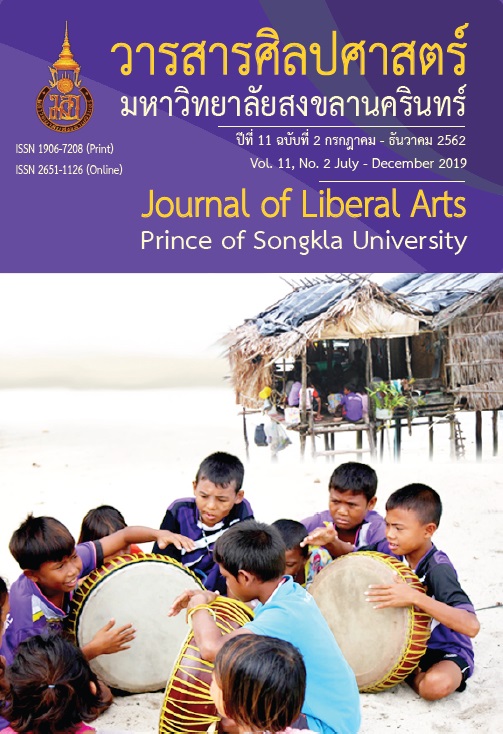การใช้วิธีให้ข้อมูลย้อนกลับแบบจับคู่และกลุ่มผ่านระบบออนไลน์ต่อการพัฒนาความสามารถด้านไวยากรณ์ภาษาอังกฤษของนักเรียน ที่มีความสามารถทางภาษาอังกฤษต่ำ
คำสำคัญ:
ข้อมูลย้อนกลับระหว่างเพื่อนออนไลน์, ความสามารถด้านไวยากรณ์ในงานเขียน, นักเรียนที่มีความสามารถต่ำ, ข้อมูลย้อนกลับระหว่างเพื่อนแบบคู่ออนไลน์, ข้อมูลย้อนกลับระหว่างเพื่อนแบบกลุ่มออนไลน์บทคัดย่อ
การวิจัยครั้งนี้มีจุดประสงค์เพื่อศึกษาและเปรียบเทียบผลการให้ข้อมูลย้อนกลับระหว่างผู้เรียนแบบจับคู่และกลุ่มผ่านระบบออนไลน์ต่อการพัฒนาความสามารถด้านไวยากรณ์ภาษาอังกฤษในการเขียนของนักเรียนกลุ่มตัวอย่างระดับมัธยมศึกษาปีที่ 6 ผู้วิจัยใช้วิธีการสุ่มแบบเจาะจงจากห้องเรียนสภาพจริง จำนวน 2 ห้องเรียน โดยกำหนดเป็นกลุ่มทดลองทั้ง 2 กลุ่ม กลุ่มทดลองที่ 1 มีนักเรียนจำนวน 22 คน และกลุ่มทดลองที่ 2 มีนักเรียนจำนวน 32 คน เครื่องมือที่ใช้ในการวิจัย ได้แก่ แบบทดสอบการเขียนก่อนและหลังเรียนเพื่อศึกษาและเปรียบเทียบความถูกต้องของการใช้ไวยากรณ์เป้าหมายก่อนและหลังการเข้าร่วมกิจกรรมการให้ข้อมูลย้อนกลับ แบบฝึกการเขียนเพื่อสำรวจความถี่ของการให้ข้อมูลย้อนกลับด้านไวยากรณ์เป้าหมาย และแบบสัมภาษณ์กึ่งโครงสร้างเพื่อศึกษาผลสะท้อนของนักเรียนที่มีต่อการให้ข้อมูลย้อนกลับด้านไวยากรณ์เป้าหมาย สถิติที่ใช้ในการวิเคราะห์ข้อมูลเชิ'ปริมาณ คือ ค่าร้อยละ ค่าเฉลี่ย ค่าเบี่ยงเบนมาตรฐาน และค่า T-test และการวิเคราะห์ข้อมูลเชิงคุณภาพ ใช้วิธีการจัดกลุ่ม ผลการวิจัยพบว่า ผลของการให้ข้อมูลย้อนกลับแบบคู่และกลุ่มต่อผลสัมฤทธิ์ทางการเขียนด้านไวยากรณ์ในภาพรวมทั้งก่อนและหลังเรียนของนักเรียน มีค่าเฉลี่ยรวมไม่แตกต่างกันอย่างมีนัยสำคัญทางสถิติ และการให้ข้อมูลย้อนกลับทั้ง 2 กลุ่ม มีค่าขนาดอิทธิพล (Cohen’s d) ต่อไวยากรณ์เป้าหมายส่วนใหญ่ในระดับต่ำ ผลการวิจัย ชี้ให้เห็นว่าการให้ข้อมูลย้อนกลับระหว่างผู้เรียนนั้นมีความสำคัญและมีประโยชน์ต่อการสอนทักษะการเขียน อย่างไรก็ตาม การให้ข้อมูลย้อนกลับจากครูยังคงมีความจำเป็นสำหรับนักเรียนที่มีความสามารถทางด้านภาษาอังกฤษในระดับต่ำ
References
Barrett, N. E., & Chen, L. M. (2011). English article errors in Taiwanese college students' EFL writing. Computational Linguistics and Chinese Language Processing, 16(3-4), 1-20.
Bennui, P. (2016). A study of L1 intereference in the writing of Thai EFL students. Malaysian Journal of ELT Research, 4(1), 31.
Caulk, N. (1994). Comparing teacher and student responses to written work. TESOL Quarterly, 28(1), 181-188.
Cheng, W., & Warren, M. (2005). Peer assessment of language proficiency. Language Testing, 22(1), 93-121.
Cho, K., & MacArthur, C. (2010). Student revision with peer and expert reviewing. Learning and Instruction, 20(4), 328-338.
Crompton, P. (2011). Article errors in the English writing of advanced L1 Arabic learners: The role of transfer. Asian EFL Journal, 50(1), 4-35.
De Guerrero, M. C., & Villamil, O. S. (1994). Social‐cognitive dimensions of interaction in L2 peer revision. The Modern Language Journal, 78(4), 484-496.
Ellis, R., Sheen, Y., Murakami, M., & Takashima, H. (2008). The effects of focused and unfocused written corrective feedback in an English as a foreign language context. System, 36(3), 353-371.
Hansen, J., & Liu, J. (2005). Guiding principles for effective peer response. ELT Journal, 59, 31–38.
Hedin, B. (2012). Peer feedback in academic writing using Google Docs. Proceedings of LTHs 7:e Pedagogiska Inspirationskonferens. Retrieved from https://www.lth.se/fileadmin/lth/genombrottet/konferens2012/12_Hedin.pdf.
Hyland, K. (2003). Second language writing. New York: Cambridge University Press.
Hyland, K. & Hyland,F. (eds.) (2006a). Feedback in second language writing: Contexts and issues. New York: Cambridge University Press.
Johnson, D. W., & Johnson, R. T. (1987). Learning together and alone: Cooperative, competitive, and individualistic learning. Englewood Cliffs, N.J: Prentice-Hall.
Kamimura, T. (2006). Effects of peer feedback on EFL student writers at different levels of English proficiency: A Japanese context. TESL Canada Journal, 23(2), 12-39.
Kaweera, C., & Usaha, S. (2008). The impact of different types of teacher written feedback on EFL university students’ writing. KKU Research Journal, 8(2), 83-94.
Likitrattanaporn, W. (2002). An analysis of English grammatical errors of third year students majoring in Accounting and Marketing, Faculty of Social Sciences, Srinakarinwirot University year 2000. Master of Arts Thesis, Srinakarinwirot Uiversity.
Mendoça, C. & K. Johnson (1994). Peer review negotiations: Revision activities in ESL writing instruction. TESOL Quarterly, 28(4), 745–768.
Nonkukhetkhong, K. (2013). Grammar error analysis of the first year English major students, Udon Thani Rajabhat University. Proceedings of the Asian Conference on Language Learning 2013. (pp. 117-126). Osaka: The International Academic Forum.
Nunan, D. (1999). Second language teaching and learning. Boston: Heinle & Heinle.
Rollinson, P. (2005). Using peer feedback in the ESL writing class. ELT Journal, 59(1), 23-30.
Shehadeh, A. (2007). The effect of group and individual peer feedback on student writing in an EFL Gulf context. In C. Coombe & L. Barlow (Eds.), Language teacher research in the Middle East (pp. 147-160). Virginia, USA: TESOL.
Siengsawang, P. (2006). An investigation of needs and opinions of the academic writing in the MA/ESP Program at Kasetsart University. Master of Art Thesis in English for Specific Purposes, Kasetsart University.
Stanley, G. (2011). Approaches to process writing. Retrieved July 4, 2011., from http://www.teachingenglish.org.uk/think/articles/approaches-process-writing.
Storch, N. (2005). Collaborative writing: Product, process and students’ reflections. Journal of Second Language Writing, 14(3), 153–173.
Storch, N., & Wigglesworth, G. (2007). Writing tasks: Comparing individual and collaborative writing. In M. P. Garcı´a Mayo (Ed.), Investigating tasks in formal language learning (pp. 157–177). London: Multilingual Matters.
Suwangard, N.(2014) Grammatical error correction and retention in EFL students: A case study of EFL students in Thailand. IOSR Journal of Humanities and Social Science (IOSR-JHSS), 19(12), 51-58.
Swain, M., Brooks, L., & Tocalli-Beller, A. (2002). Peer-peer dialogue as a means of second language learning. Annual Review of Applied Linguistics, 22, 171-185.
Swain, M., & Lapkin, S. (2002). Talking it through: Two French immersion learners’ response to reformulation. International Journal of Educational Research, 37(3), 285-304.
Swain, M., & Watanabe, Y. (2013). Languaging: Collaborative dialogue as a source of second language learning. In C. Chapelle (Ed.), The encyclopedia of applied linguistics (pp. 1-8). Oxford: Wiley-Blackwell.
Tsay, M., & Brady, M. (2012). A case study of cooperative learning and communication pedagogy: Does working in teams make a difference? Journal of the Scholarship of Teaching and Learning, 10(2), 78-89.
Tsui, A. B., & Ng, M. (2000). Do secondary L2 writers benefit from peer comments? Journal of Second Language Writing, 9(2), 147-170.
Tuzi, F. (2004). The impact of e-feedback on the revisions of L2 writers in an academic writing course. Computers and Composition, 21(2), 217-235.
Van der Geest, T., & Remmers, T. (1994). The computer as means of communication for peer-review groups. Computers and Composition, 11(3), 237-250.
Vygotsky, L. (1978). Mind in society: The development of higher psychological processes. Cambridge, MA: Harvard University Press.
Watcharapunyawong, S., & Usaha, S. (2013). Thai EFL students' writing errors in different text types: The interference of the first language. English Language Teaching, 6(1), 67.
Wertsch, J. V. (1991a). A sociocultural approach to socially shared cognition. In L. B. Resnick, J. M. Levine, & S. D. Teasley (Eds.), Perspectives on socially shared cognition (pp. 85–100). Washington, DC: American Psychological Association.
Williams, J., & Cui, G. (2005). Teaching writing in second and foreign language classrooms. New York: McGraw-Hill.
Yu, S., & Lee, I. (2015). Understanding EFL students’ participation in group peer feedback of L2 writing: A case study from an activity theory perspective. Language Teaching Research, 19(5), 572-593.
Yu, S., & Lee, I. (2016). Understanding the role of learners with low English language proficiency in peer feedback of second language writing. TESOL Quarterly, 50(2), 483–494.
Zhu, W. (2001). Interaction and feedback in mixed peer response groups. Journal of Second Language Writing, 10(4), 251-276.
Downloads
เผยแพร่แล้ว
How to Cite
ฉบับ
บท
License
ลิขสิทธิ์บทความเป็นของผู้เขียน แต่วารสารศิลปศาสตร์ มหาวิทยาลัยสงขลานครินทร์ ขอสงวนสิทธิ์ในการเป็นผู้ตีพิมพ์เผยแพร่เป็นครั้งแรก




